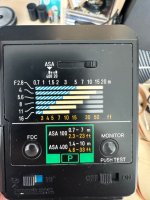- Messages
- 3,417
- Name
- Kell
- Edit My Images
- Yes
I won’t bore you with all the details of the why’s, but I was planning on taking this flash with me to use on top of a film camera loaded with CineStill 800 film.
Now, it’s got settings on the back to tell you which f/stop to use based on your film rating and the distance you are from subject.
Except it only goes up to 400 ASA.
I’m totally confused as to what I could do to use it with something rated at 800 ASA.
Is it even possible? I’m posting here as I don’t even know what to look for to google it.
Anyone know the answer and is able to explain it in terms an idiot would understand.
It’s decades since I studied photography and to be honest I’m not sure I ever really understood lighting.
Flash sync setting for this camera is 1/60. You can go slower (but that doesn’t help here) but not faster.
Thanks to anyone that can help.

Now, it’s got settings on the back to tell you which f/stop to use based on your film rating and the distance you are from subject.
Except it only goes up to 400 ASA.
I’m totally confused as to what I could do to use it with something rated at 800 ASA.
Is it even possible? I’m posting here as I don’t even know what to look for to google it.
Anyone know the answer and is able to explain it in terms an idiot would understand.
It’s decades since I studied photography and to be honest I’m not sure I ever really understood lighting.
Flash sync setting for this camera is 1/60. You can go slower (but that doesn’t help here) but not faster.
Thanks to anyone that can help.

Last edited:

